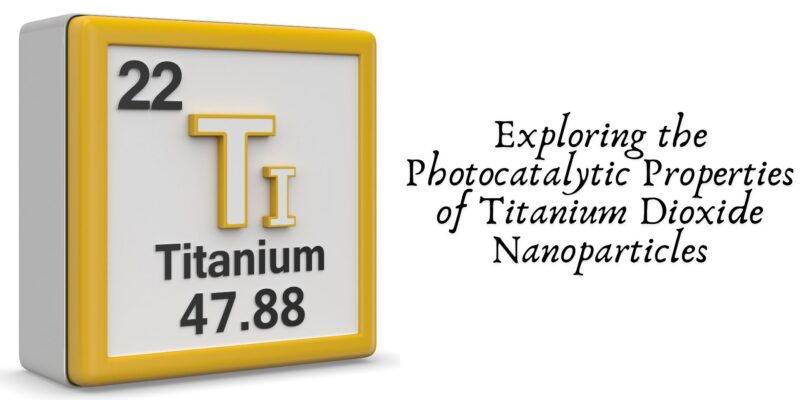Titanium dioxide nanoparticles have emerged as a transformative material in photocatalysis, revolutionizing applications ranging from environmental remediation to energy generation. Their unique properties, including high stability, non-toxicity, and strong oxidative power, make them indispensable in diverse industries. This article delves into the photocatalytic properties of TiO₂ nanoparticles, examining their mechanisms, applications, and future potential.
Understanding Photocatalysis with TiO₂ Nanoparticles
Photocatalysis refers to a chemical reaction driven by light energy, typically in the ultraviolet (UV) spectrum. When TiO₂ nanoparticles are exposed to UV light, they absorb photons, exciting electrons in the valence band to the conduction band. This process generates electron-hole pairs, which are key to initiating redox reactions.
-
Electron-Hole Pair Dynamics: The excited electrons reduce oxygen molecules to superoxide anions, while the holes oxidize water to hydroxyl radicals. Both reactive species are powerful oxidants capable of breaking down organic and inorganic pollutants.
-
Band Gap Energy: The photocatalytic efficiency of TiO₂ is primarily attributed to its band gap energy of approximately 3.2 eV, enabling the absorption of UV light.
Applications of TiO₂ Nanoparticles in Photocatalysis
The versatility of TiO₂ nanoparticles has spurred their use in a wide array of applications:
Environmental Remediation
-
Water Treatment: TiO₂ nanoparticles effectively degrade organic pollutants, dyes, and pharmaceuticals in wastewater. Their application in photocatalytic reactors has significantly advanced water purification technologies.
-
Air Purification: These nanoparticles break down volatile organic compounds (VOCs) and nitrogen oxides (NOx), contributing to cleaner air in urban environments.
Self-Cleaning Surfaces
TiO₂ nanoparticles are widely used in coatings for self-cleaning surfaces. These surfaces repel dirt and organic contaminants when exposed to sunlight, maintaining cleanliness without frequent manual cleaning.
Solar Energy Conversion
-
Dye-Sensitized Solar Cells (DSSCs): TiO₂ nanoparticles serve as a photoanode in DSSCs, where they facilitate electron transport, improving the overall efficiency of solar energy conversion.
-
Hydrogen Production: In photocatalytic water splitting, TiO₂ nanoparticles are employed to generate hydrogen, a clean and sustainable energy source.
Antimicrobial Applications
TiO₂ nanoparticles exhibit strong antibacterial and antifungal properties due to their ability to generate reactive oxygen species (ROS), making them useful in sterilization and medical device coatings.
Challenges in TiO₂ Photocatalysis
Despite their advantages, TiO₂ nanoparticles face certain limitations:
-
UV Dependence: Their reliance on UV light limits their efficiency under natural sunlight, which predominantly consists of visible light.
-
Electron-Hole Recombination: Rapid recombination of electron-hole pairs reduces photocatalytic efficiency.
-
Stability in Complex Matrices: The performance of TiO₂ can degrade in complex environments containing interfering substances.
Enhancements and Innovations
Researchers have developed several strategies to overcome these challenges and enhance the photocatalytic performance of TiO₂ nanoparticles:
-
Doping: Introducing non-metal or metal dopants (e.g., nitrogen, silver) reduces the band gap, enabling visible-light activation.
-
Composite Formation: Combining TiO₂ with other materials, such as graphene or zinc oxide, improves charge separation and overall efficiency.
-
Nanostructuring: Creating advanced nanostructures, such as nanotubes or hollow spheres, enhances surface area and light absorption.
Future Directions and Potential
The ongoing research in TiO₂ nanoparticles holds immense promise for expanding their applications:
-
Renewable Energy: As efforts intensify toward achieving sustainable energy solutions, TiO₂ nanoparticles could play a pivotal role in advancing solar fuels and energy storage systems.
-
Smart Materials: Integration into smart coatings and devices can pave the way for intelligent environmental solutions, such as adaptive air and water purification systems.
-
Biocompatible Innovations: Exploring their potential in medical fields, including drug delivery and biosensors, could unlock new frontiers in healthcare.
Conclusion
Titanium dioxide nanoparticles represent a cornerstone of modern photocatalysis, bridging scientific innovation with practical applications. Their unparalleled ability to harness light for environmental and energy solutions underscores their significance in addressing global challenges. With continuous advancements in nanotechnology, the future of TiO₂ nanoparticles appears brighter than ever, promising transformative impacts across industries.
